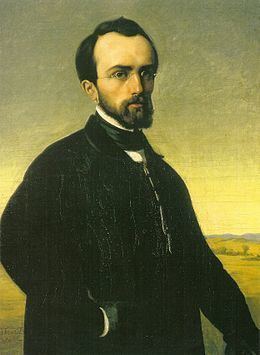Died 1889 | ||
 | ||
Jean-Baptiste Frénet (1814-1889) was a French painter, sculptor, photographer and politician based in Lyon.
Contents
Life
He was born in Lyon on 31 January 1814, the son of a manufacturer of silk cloth. He learned the artistic aspects of the silk trade from his father and attended the School of Fine Arts in lyon between 1827 and 1833, studying painting and life drawing. In 1835 he moved to Paris to continue his training in the studio of Jean-Auguste-Dominique Ingres.
He then attended Frédéric Ozanam's college within the Society of Saint Vincent de Paul , which advocated Catholic libertarian values, (which were condemned by the Pope). This period was inspirational for Frénet and inspired his later religious works.
Following the closure of Ingres' workshop, Frénet, with his friends Louis Janmot and Claudius Lavergne, undertook a study trip to Italy to visit Inges, where the latter had become Director of the Academy France to Rome. A small colony from Lyon, also including Hippolyte Flandrin, centred around Ingres in the Villa Medici: they draw and paint the Roman monuments. In 1837 Frénet visited Florence and then leaves Italy.
Back in Lyon, Jean-Baptiste Frénet made his first public exhibition at the 1837 Exhibition, which consisted of works brought back from Italy. In 1840 he made a second trip to Italy and again exhibited his work in return to France. He thereafter became a recognized member of the School of Lyon. However, art critics were not always kind to him. Failing to win any prizes in Paris where he exhibited at the Salon in 1841, he decided to relocate to the village of Charly , near Lyon, where he had bought a house.
He continued his paintings, mostly religious subjects, including both frescoes and stained glass for the Saint-Louis-de-la-Guillotière church in Charly. Following the Revolution of 1848 , he became involved in municipal politics, and was elected Mayor of Charly. He also then applied to become a Professor at the School of Fine Arts in Lyon, supported by Ingres, but was unsuccessful.
His range then diversified, covering various other techniques: printmaking, sculpture, and a strong interest in the new field of photography.
From 1850 he worked on a large fresco project for the church of St. Martin in Ainay, but unfortunately moisture deteriorated his work, and his sponsors refused to pay. The works were ultimately destroyed. Embittered, Frénet thereafter didn't produce anything before his death on 12 August 1889.
Photography
Around 1850 Frénet, met some photography pioneers in Lyon, and used photography to record his unsuccessful frescoes at Ainay. From this time, he becomes passionate about this new medium, and this mentally diverts him from the setbacks with his painting.
Frénet applies to out of decision stereotypical views of the time involving heavy stagings, and is one of the first to practice the instant, the familiar and intimate subject. Five years before Nadar , it produces psychological portraits and engages in close-up. He considers photography as an art, that opinion has emerged in the first issue of The Light body of the young and ephemeral gravure Company founded in 1851. Frénet open professional practice of photography in 1866 and 1867 Lyon.
Unknown to the general public, his photographic work was discovered in 2000 at the sale of his photographic collection, where many parts are purchased by the Musée d'Orsay
Family
Photographic evidences shows that he was married with three daughters.
